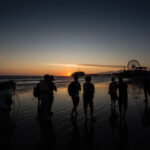Whether you’re an hobbyist photographer about to embark on a much-needed vacation with your family or an amateur professional photographer preparing for your first legitimate assignment abroad, you would do well to glean as much wisdom as possible from expert travel photographer Richard I’Anson.
In the following video, I’Anson discusses the fundamentals of travel photography, including the ins and outs of selecting camera gear, traveling with photography as your main priority, and mastering creative control in difficult shooting conditions:
I’Anson provides the following 15 valuable pieces of advice for aspiring travel photographers, saying that they’re largely responsible for his own success in the industry:
1. Be committed.
In the video, I’Anson puts great emphasis on the importance of “committing to the image” and committing to travel photography, in general. You can’t expect to become a successful travel photographer, I’Anson says, if you’re unwilling to sacrifice the time, finances, and comfort necessary to make photography your number one priority during your travels.
“Nothing gets higher priority than being in the right place at the right time all of the time —not food, not sleep, not comfort, not family, not friends, nothing,” said I’Anson. “This is because it’s one thing to take the occasional good photo, but it’s quite another to take consistently creative images day after day in all sorts of environments [and] in all sorts of conditions.”
2. Think outside the box.
If you choose to photograph a popular tourist attraction or landmark, don’t stand where the trigger-happy tourists are standing. Think outside the box. Change viewpoints to get a higher or lower perspective, revisit the location at a different time of day, or set up camp and wait for something out-of-the-ordinary to happen. I’Anson believes that it’s always possible to “defy automation” and set your images apart if you’re willing to put in the work to create something unique.
“Great photos… are unique moments in time captured by photographers who can see, select, and organize the elements before them into a visually cohesive and unique composition and then translate that vision onto the sensor,” said I’Anson. “You need to work through a series of decisions regarding exposure, composition, and light… [this] produces unique images and allows individuality to shine through.”
3. Select your gear strategically.
Savvy travel photographers pack fairly lightly. Bring enough gear to ensure that you can shoot effectively in any situation, but not so much that you become burdened down or draw too much attention to yourself.
“You can expect to be out and about for hours at a time, all the while watching and waiting for that great shot,” said I’Anson. “So unless you have specific aims that demand a truckload of specialist equipment, I recommend that you keep your gear simple, accessible, and manageable.”
I’Anson always carries two Canon EOS-1DX DSLR cameras as he explores town, one equipped with a wide angle 16-35mm f/4L or mid-range 24-70mm f/2.8L zoom lens, and the other equipped with a 70-200mm f/2.8L telephoto zoom. He also usually brings along an assortment of professional-grade Hoya filters, SanDisk CF and SDHC memory cards totaling 64GB of storage space, and a Canon Speedlite 430EX II.
When shooting subjects from a considerable distance, I’Anson packs his 200-400mm f/4L IS USM Extender 1.4X super telephoto lens and Gitzo G1228 carbon-fiber tripod.
4. Research, research, research.
One of the keys to successful travel photography is being in the right place at exactly the right time. Performing meticulous research in advance of your trip will prepare you to navigate your destination effectively, make you aware of photo-worthy locations and special events in the area, and greatly enhance your ability to predict where you should be and when you should be there.
As you research, create an ideal “shot list” of all of the areas and landmarks you want to visit and photograph during your trip, and plan your sunset and sunrise shoots. This will make it easier for you to organize your priorities according to the length of your visit.
“Research and planning go a long way to getting you to the right place at the right time more often than not,” said I’Anson. “The more time you have, the more opportunities you give yourself to photograph subjects in the best light… sometimes just a few extra minutes can make all the difference.”
5. Plan, but leave time for wandering.
While creating your photography itinerary, be sure to dedicate time windows to exploring the city without any particular agenda. Visit landmarks you’re interested in seeing, browse through shops and markets, and talk to locals. During this time, you’re bound to stumble across photogenic moments and discover locations that you should to revisit in better light.
“I always know where I’m going and what I’m photographing in the couple of hours around sunrise and sunset when the light is at its best,” said I’Anson. “Having said that, I always allow time just to wander and discover new things for myself because very often, the most satisfying photos come on these unstructured walks.”
6. Patiently watch and wait.
One of the key characteristics of successful travel photographers is that, when they identify a promising photo opportunity, they’re willing to wait with infinite patience for the right time of day or the right circumstances in order to capture the most visually appealing and dynamic images.
As you explore your destination, incessantly analyze your surroundings. Try to predict when photogenic moments might take place, and if things don’t line up right then, be willing to wait around or revisit the location when the situation improves.
“Very few really good photographs are the result of random machine gun fire technique or accidentally being in the right place at the right time,” I’Anson said. “If possible, wait… whether it’s a matter of seconds for an action to occur, a couple of hours for the weather to change, or revisiting a location at the best time of day, the quality of your images will improve dramatically.”
7. Shoot in RAW and learn your editing software.
If you want to succeed as a professional travel photographer, you need to be shooting in RAW if you want to leverage the full capabilities of your equipment. This becomes especially important if you’re planning to display or reproduce your work in large formats. Since RAW files require significant post processing, it’s also important to learn how to utilize your image editing software to its full potential.
“Being proficient with image editing software is a vital skill for the photographer,” said I’Anson. “Your investment in time, software, and computer equipment will be rewarded with the ability to bring your images to life and have total control over how they look.”
8. Set up quickly to capture fleeting moments.
In the video, I’Anson emphasizes the importance of knowing your gear so well that you can get ready to shoot in a matter of seconds. Practice quickly adjusting ISO, shutter speed, and aperture, operating your flash, changing lenses and filters, setting up your tripod, mounting your camera, and attaching your shutter release cable until you have the process down to an art.
“Many photo opportunities don’t repeat themselves,” said I’Anson. “Missing the moment because you’re trying to figure out how the camera works is frustrating and avoidable.”
9. Understand ISO, shutter speed, and aperture.
Understanding and mastering the basics of photography, such as how ISO, shutter speed, and aperture work together to determine an image’s exposure, clarity, and compositional effectiveness, will allow you to create engaging images with full creative control.
“Get to know your gear so that the mechanics of taking a photograph become second nature,” said I’Anson. “Use the settings as creative tools that control the mood, quality, and feel of the photograph rather than just as a technical necessity.”
10. Obey the rule of thirds.
Each time you compose an image, imagine a two vertical and two horizontal lines that break the image up into nine sections. In most cases, placing the main subject onto one of the points where these gridlines intersect will result in an effective composition.
“Aim to place the point of interest away from the center of the frame,” said I’Anson. “If you’re taking a portrait, for example, the subject is the person’s face and the point of interest would be his or her eyes. In the landscape, the point of interest may be the peak of a mountain, [so] place the peak on one of the intersections.”
11. Draw attention to the main subject.
The goal of every composition should be to draw the viewers’ eye to the main subject, whether this is a face, the peak of a mountain, or a person wearing a vibrant red jacket in a sea of blue clothing. Varying your point of view or camera orientation, using the rule of thirds, and eliminating distracting elements through your focusing choices are all effective ways to guide viewers to focus on your main subject… assuming you know what your main subject is.
“Successful images have a point of interest,” said I’Anson. “It’s probably the thing that caught your eye in the first place. Good compositions leave no doubt as to the subject of the photograph.”
12. Find the right light.
It’s not enough to understand how to operate your equipment. If you want to have any hope of commanding perfect creative control in all circumstances, you must understand light itself — namely, its direction, color, and quality. This is why many photographers gravitate toward shooting in the hours just after sunrise and just before sunset; at these times, the light is soft but potent, and its warmer tones flatters most subjects.”
“There’s light and then there’s the right light,” said I’Anson. “To be able to see light and to understand how it translates onto the sensor and how it impacts on your compositions is the final step in creating striking images.”
13. Develop your unique style.
As you learn how ISO, aperture, shutter speed, and other equipment settings affect your photographs and master your image editing software, you should start noticing patterns in the way that you compose and post-process images. If you hone these preferences effectively, you’ll begin to develop a unique style that will set your photographs apart from the work of others in your niche.
“There is no one single or correct composition for any given subject or scene and it’s often worth trying several different compositions,” said I’Anson. “Experience and practice will teach you how to create striking compositions quickly. Along the way, you’ll develop your own preferences and style.”
14. Practice in your hometown.
The best travel photographers honed their skills through practice and you must do the same — but you don’t have to travel to exotic locations to gain experience. Learn compositional techniques and get to know your equipment by photographing birds in your backyard. Roam the streets of your city asking locals if you can take their portraits. You’ll encounter the same types of lighting situations and circumstances as you would while traveling abroad.
“Planning and executing a shoot of your own city is a great way to practice your research skills, test your camera equipment, perfect your technique, develop your eye, and get a feel for changing light,” said I’Anson. “You’ll quickly get an insight into just how much walking you can expect to do, how many locations and subjects you can expect to photograph in a day, and how manageable your equipment is.”
15. Critique your work objectively.
Whether you’re culling through the images you created during your professional travels or during a practice shoot you conducted in your hometown, be sure to study the photographs that don’t work out before you trash them. Critique these images objectively to figure out what you did wrong and don’t be afraid to ask a trusted third party to provide honest feedback if you need help identifying your mistakes. This will help you to avoid failure the next time you go out shooting.
“If you want your pictures to stand out, a disciplined assessment of your photographs will give them the best chance of catching people’s attention and being appreciated,” said I’Anson. “Study them to see what you did wrong and what you did right… [then] you can eliminate the causes of your failures and concentrate on the things that worked.”
While there are countless other viewpoints on becoming a stronger travel photographer, we think that I’Anson is on to something here with these 15 tips—especially his emphasis on fully committing to travel photography, rather than just taking photos while traveling when it’s convenient. Here’s to many amazing travel images to come!
Like This Article?
Don't Miss The Next One!
Join over 100,000 photographers of all experience levels who receive our free photography tips and articles to stay current:





















“I’Anson provides the following 15 valuable pieces of advice for aspiring travel photographers, saying that they’re largely responsible for his own success in the industry:”
This article forgets to mention one very important thing. Unless you are going to invest in all this gear and cost of travel to remote locations for free or for fun, you are going to want to try and sell or make money from your work on your return.
And that’s where the fun begins.
There used to be a market for photographers to sell very good travel work on stock photography libraries. Sadly, due to oversupply of travel images from thousands of digital carrying amateurs coupled with stock libraries treating photographers like battery hens with low commissions, low prices and low sales you’ll be lucky to see $5 from images even as good as these on regular sites and far less on microstock sites. Nowadays and you need thousands of images placed with libraries to make just a handful of sales each month and travel photos are the hardest to sell because many publishers know they can get them for free from Flickr and other photo sharing sites ‘for a credit’. This is the state of the photo industry in 2016.
Most trips abroad from your home country will never make you a profit. Forget the romantic dream of being a paid travel photographer unless you are independently wealthy. Those days are long gone.
I am from India thanks for your advise for travel photography I love travel photography and wan to increase my skill. this is very help full for me thanks.
When the control situation is their I always use tripod for best result and for maximum Depth
I recommend all photographer to use tripod for best result
Thanks
– Ashok Prajapati
Thank you for a very detailed and comprehensive advice on the subject of travel photography. While not denying the importance of all of the tips, tips such as honing your skills in your hometown and knowing your camera thoroughly strike to me as most important.
Most of the photographs, excellent in quality, support the point under discussion. Excellent choice.
No mention of a tripod in the recommended equipment has eft me wondering. Is there a special reason for the omission?
Thanks once again.
Sincerely yours,
— Ravindra Kathale